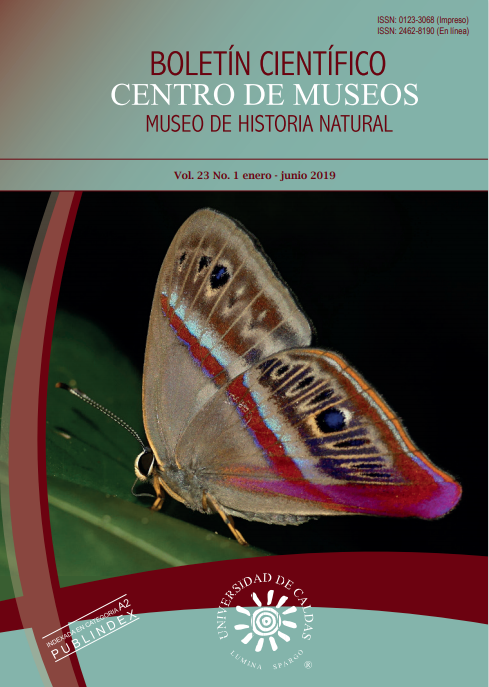Authors
Abstract
Objective: To evaluate different sources of honey in the larvae culture of Galleria mellonella for the massive production of entomopathogenic nematodes. Methodology: Brown sugar, honey of bees, raw sugar cane honey, purge honey and powdered raw sugar cane were evaluated for G. mellonella larvae culture as well as their cost in the diets; life cycle of the insect was also determined. Results: Larvae fed with raw sugar cane developed similarly to those who had the conventional diet (honey of bees). However, the period between egg-adult (59.5 days) and the cost of production (22% less) were reduced when brown sugar was used compared to the conventional diet. Conclusion: Brown sugar is a viable alternative to replace honey in conventional diets, which translates into lower production costs of entomopathogenic nematodes.
Keywords
References
CHANDEL, Y.S., SHARMA, S. & VERMA, K.S., 2003.- Comparative biology of the greater wax moth, Galleria mellonella L., and lesser wax moth, Achoria grisella. Forest Pest Management and Economic Zoology, 11: 69-74.
CHARRIERE, J.D. & IMDORF, A., 1999.- Protection of honey combs from wax moth damage. Am. Bee J., 139: 627-630.
GRIFFIN, C.T., BOEMARE, N.E. & LEWIS, E.E., 2005.- Biology and Behaviour: 47-64 (en) GREWAL, P.S., EHLERS, R.U. & SHAPIRO-ILAN, D.I. (eds.) Nematodes as biocontrol agents. Oxfordshire: CABI Publishing.
GULATI, R. & KAUSHIK, H., 2004.- Enemies of honeybees and their management-A review. Agric. Rev., 25: 189-200.
HANUMANTH, A. & SWAMY, B.C., 2008.- Bionomics and biometrics of Greater wax moth Galleria mellonella Linnaeus. Asian J. of Bio Sci., 3(1): 49-51.
HOSAMANI, V., HANUMANTHA, B.C., KATTIMANI, K.N. & KALIBAVI, C.M., 2017.- Studies on Biology of Greater Wax Moth (Galleria mellonella L.). Int. J. Curr. Microbiol. App. Sci., 6(11): 3811-3815.
JACKMAN, J.A. & DREES, B.M., 1998.- A field guide to Texas insects. Houston: Gulf Publishing Company.
JIMÉNEZ, J.A., LÓPEZ, J.C. & SOTO, A., 2012.- Patogenicidad de dos nematodos entomopatógenos sobre Metamasius hemipterus sericeus (Coleoptera: Curculionidae). Bol. Cient. Mus. Hist. Nat. U. de Caldas, 16(2): 87-97.
KAYA, H. & STOCK, S., 1997.- Techniques in insect nematology: 281-324 (en) LACEY, L. (ed.) Manual of techniques in insect pathology. San Diego: Academic Press.
KAYA, H.K., AGUILERA, M.M., ALUMAI, A., CHOO, H.Y., TORRE, M. de la & FODOR, A. et al., 2006.- Status of entomopathogenic nematodes and their symbiotic bacteria from selected countries or regions of the world. Biological Control, 38: 134-155.
KWADHA, C.A., ONG’AMO, G.O., NDEGWA, P.N., RAINA, S.K. & FOMBONG, A.T., 2017.- The biology and control of the greater wax moth, Galleria mellonella. Insects, 8(2): 61-76.
KUMAR, G. & KHAN, M.S., 2018.- Study of the life cycle of greater wax moth (Galleria mellonella) under storage conditions in relation to different weather conditions. Journal of Entomology and Zoology Studies, 6(3): 444-447.
LÓPEZ, J.C., PLICHTA, K., GÓNGORA, C.E. & STOCK, S.P., 2007.- A new entomopathogenic nematode, Steinernema colombiense n. sp. (Nematoda: Steinernematidae) from Colombia. Nematology. En prensa.
LÓPEZ, J.C. & STOCK, P., 2008.- First isolation of Heterorhabditis bacteriophora Poinar 1976 (Nematoda: Heterorhabditidae), in Colombia. Journal of Invertebrate Pathology. En prensa.
LÓPEZ, R.A. & SOTO, A., 2016.- Aislamiento de nematodos entomopatógenos nativos en cultivos de caña panelera y pruebas de patogenicidad sobre Diatraea saccharalis (Lepidoptera: Crambidae). Bol. Cient. Mus. Hist. Nat. U. de Caldas, 20(2): 114-123.
MELO, E.L., ORTEGA, C.A., ALPER SUSURLUK, A., ANDREAS, G. & BELLOTTI, A.C., 2009.- Poblaciones nativas de nematodos entomopatógenos (Rhabditida) en cuatro departamentos de Colombia. Revista Colombiana de Entomología, 35(1): 28-33.
MOHAMED, A.A., 1983.- Biological and ecological studies on the greater wax moth (Galleria mellonella L.): Tesis, Faculty of Agriculture, Minia University, Egypt.
MOHAMED, A.A., MOHAMED, J.A., AHMAD, A., MOHAMED, O.M. & MANPREET, K., 2014.- Effect of larval nutrition on the development and mortality of Galleria mellonella (Lepidoptera: Pyralidae). Revista Colombiana de Entomología, 40(1): 49-54.
RAMARAO, N., NIELSEN, C. & LERECLUS, D., 2012.- The Insect Galleria mellonella as a Powerful Infection Model to Investigate Bacterial Pathogenesis. J Vis Exp., 70: 4392.
REALPE, F.J., BUSTILLO, A.E. & LÓPEZ, J.C., 2007.- Optimización de la cría de Galleria mellonella (L.) para la producción de nematodos entomopatógenos parásitos de la broca del café. CENICAFÉ, 58(2): 142-157.
SÁENZ, A. & OLIVARES, W., 2008.- Capacidad de búsqueda del nematodo entomopatógeno Steinernema sp. SNIO 198 (Rhabditida: Steinernematidae). Revista Colombiana de Entomología, 34(1): 51-56.
SALAS, M.A., 2015.- Efecto de dietas artificiales en la crianza de Galleria mellonella L. (Lepidoptera: Pyralidae): Tesis, Universidad Nacional de Trujillo, Perú.
SEPULVEDA, P.A., LÓPEZ, J.C. & SOTO, A., 2008.- Efecto de dos nematodos entomopatógenos sobre Cosmopolites sordidus (Coleoptera: Dryophthoridae). Revista Colombiana de Entomología, 34(1): 62-67.
TRAIYASUT, P., MOOKHPLOY, W., KIMURA, K., YOSHIYAMA, M., KHONGPHINITBUNJONG, K. & CHANTAWANNAKUL, P., et al., 2016.- First detection of honey bee viruses in wax moth. Chiang Mai J. Nat. Sci., 43: 695-698.
VAN, C. & MALAN, A., 2015.- Cost-Effective Culturing of Galleria mellonella and Tenebrio molitor and Entomopathogenic Nematode Production in Various Hosts. African Entomology, 23(2): 361-375.
WILLIAMS, J.L., 1997.- Insects: Lepidoptera (moths): 121-141 (en) MORSER, R.A. & FLOTTUM, K. (eds.) Honey Bee Pests, Predators, and Diseases. Medina: AI Root Company.

 PDF (Español)
PDF (Español)
 FLIP
FLIP






















